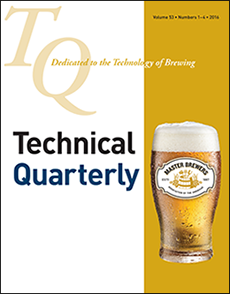|
|
DisplayTitle Top 10 Technical Quarterly Articles of 2021
Page Content In case you missed them, here are the 10 most popular Technical Quarterly articles published in 2021. Thanks for reading and submitting!  Fermentation Quality Control: Including Fermentation in Your Beer Recipe Fermentation Quality Control: Including Fermentation in Your Beer Recipe
Tim Faith (Goose Island Beer Company) discusses a way to effectively track and document fermentation analytics, visualize data, strive for continuous improvement through trials, and help the brewer create and implement a quality control plan for fermentation.
Jessica Young (Bearded Iris Brewing Company) describes a technique for harvesting midfermentation and storing highly active yeast, while still allowing for dry hopping midfermentation. William Maca (HWM Yeast Solutions LLC) provides guidance to brewers with a back-to-basics approach to fermentation monitoring touching on fermentation process parameters, the definitions of viability and vitality and how to measure them, and how to use these measurements to determine the suitability of harvested yeast for repitching.
Karen Fortmann (White Labs, Inc.), Chris White (White Labs, Inc.), Mario Guadalupe (University of Florida), Paul Sarnoski (University of Florida), and Andrew J. MacIntosh (University of Florida) examine how manipulation of the headspace pressure results in a variation of the CO2 concentration and how this can be used to influence both the production of flavor compounds and the fermentation rate.
Gregory Casey reviews the American brewing industry during the tumultuous years of World War II (1941–1945) and those immediately following in support of global famine relief (1946–1948), a period that saw a production rising by just over 36 million barrels of beer, an increase of 65.3%.
Scott Janish (Sapwood Cellars) shares what he has learned to date through his dry hop research, experience on the commercial scale, and tips from other experienced experts in the brewing industry.
Leandro Meiners (PLACEBO Brewing) and Matías Cavanna (Dos Dingos Cerveza Independiente) review the academic literature on biotransformation and attempt to elucidate if biotransformation is the main driving force behind the observed sensory changes of different dry hop timings or if other physical, biological, or chemical processes take a lead role.
Martin Biendl (Hopsteiner), Christina Schmidt (Hopsteiner), John Paul Maye (S.S. Steiner, Inc), and Robert Smith (S.S. Steiner, Inc) used headspace GC‑MS and GC-MS/MS methods to analyze commercial samples of New England India Pale Ale and investigate their typical aroma profiles.
Ryohei Teraoka (Miyagi University), Makoto Kanauchi (Miyagi University), and Charles W. Bamforth (Sierra Nevada Brewing Company) immersed hop samples in various solutions containing sugar or starches and monitored for enzyme levels over a period of 28 days. They hypothesize that the starch-degrading enzymes reported in hop materials are primarily furnished by microorganisms.
Jeff Stuffings (Jester King Craft Brewery) shares the recipe and history of Le Petit Prince, a simple, rustic, mixed-fermentation beer that is dry, hoppy, with interesting fermentation character and very drinkable at under 3% ABV.
If you're interested in publishing in the TQ in 2022, learn more about the submission and publication process.
|
|
|
